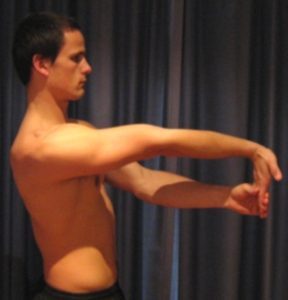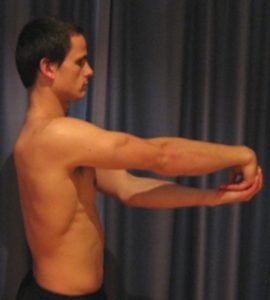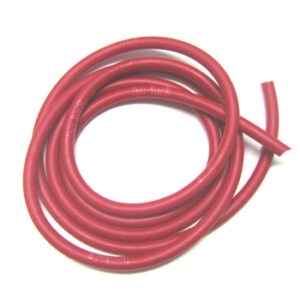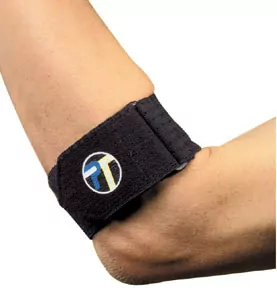Ulnar Nerve Compression
Updated:
(Also known as Funny Bone Syndrome)
What is ulnar nerve compression?
Ulnar nerve compression is a condition characterized by pressure being placed on the ulnar nerve as it passes along the inner aspect of the elbow (funny bone).
The ulna nerve originates from several spinal nerves in the neck and travels through the upper arm, into the forearm, hand and fingers. It passes the elbow in a shallow groove situated at the inner aspect of the elbow between the medial epicondyle and olecranon (figure 1). The ulna nerve is responsible for supplying sensation to the inner aspect of the forearm, the palm of the hand on the little finger side, the little finger and half of the ring finger. It is also responsible for supplying some muscles of the forearm and hand.

Following a direct impact to the inner aspect of the elbow, the ulnar nerve may be compressed. In addition, damage and inflammation of tissue adjacent to the ulnar nerve may also place pressure on the nerve. When this occurs the condition is known as ulnar nerve compression.
Ulnar nerve compression can occur at any age and is more common in the dominant arm especially in the case of overuse injuries. Occasionally, it may affect both arms.
Causes of ulnar nerve compression
Ulnar nerve compression most commonly occurs due to a direct impact to the nerve as it passes the inner aspect of the elbow. This is particularly common during a fall onto the elbow or due to a direct impact from an object or person. This may injure and compress the nerve directly or damage adjacent tissue causing inflammation, swelling and subsequent secondary compression of the nerve. Adjacent tissue may also be damaged due to overuse (such as excessive gripping activities) again placing pressure on the ulnar nerve due to inflammation, swelling and scar tissue formation.
Ulnar nerve compression may also occur due to excessive traction to the nerve. This is particularly common in the throwing athlete whereby their elbow is subject to excessive valgus forces in the cocking phase of throwing.
The nerve may also be compressed as is passes through one of the muscles of the forearm (flexor carpi ulnaris) typically due to muscle overdevelopment (associated with weight training) or overuse and subsequent inflammation and scar tissue formation.
Bony irregularities (such as spurs) within the groove between the olecranon and medial epicondyle may also contribute to ulnar nerve compression and is typically associated with overuse injuries in the throwing athlete.
A history of wrist, elbow, shoulder, neck or upper back injury may also increase the likelihood of a patient developing this condition.
The above factors alone or in combination with each other may contribute to the development of ulnar nerve compression.
Signs and symptoms of ulnar nerve compression
The symptoms associated with ulnar nerve compression may develop suddenly or gradually over a period of time. Symptoms may include an ache or pain at the back or inner aspect of the elbow and forearm, pins and needles, numbness or a burning sensation may also be present in a similar area or into the palm on the little finger side of the hand, the little finger and half of the ring finger. Tenderness and an increase in symptoms may be experienced when firmly pressing or tapping the nerve at the inner aspect of the elbow. Occasionally, in more severe cases, weakness of the hand and fingers may also be present.
In patients with inflammation contributing to the condition, symptoms may be worse at night or first thing in the morning. Occasionally, ulnar nerve compression may be associated with neck or upper back pain on the same side. In severe cases of ulnar nerve compression, obvious wasting of the muscles of the hand and forearm may be detected.
Diagnosis of ulnar nerve compression
A thorough subjective and objective examination from a physiotherapist may be sufficient to diagnose ulnar nerve compression. Nerve conduction studies may also be required to confirm diagnosis.
Treatment for ulnar nerve compression
Many cases of ulnar nerve compression settle well with appropriate physiotherapy. This includes careful assessment by the physiotherapist to determine which factors have contributed to the development of the condition, with subsequent correction of these factors.
The success rate of treatment for patients with this condition is largely dictated by patient compliance. One of the key components of treatment is that the patient rests sufficiently from any activity that increases their symptoms until they are symptom free. Activities which place large amounts of stress through the elbow and forearm should be minimized, these include: throwing, racquet sports, gripping activities, opening jars, cans or doors, carrying or lifting. Resting from aggravating activities ensures that the body can begin the healing process in the absence of further tissue damage. Once the patient can perform these activities pain free, a gradual return to these activities is indicated provided there is no increase in symptoms.
Ignoring symptoms or adopting a ‘no pain, no gain’ attitude is likely to lead to the problem becoming chronic. Immediate, appropriate treatment in patients with ulnar nerve compression is essential to ensure a speedy recovery. Once the condition is chronic, healing slows significantly resulting in markedly increased recovery times.
Patients with ulnar nerve compression will usually benefit from following the R.I.C.E regime. The R.I.C.E regime is beneficial in the initial phase of the injury (first 72 hours) or when inflammatory signs are present (i.e. morning pain or pain with rest). This involves resting from aggravating activities, regular icing, the use of a compression bandage and keeping the arm elevated. Anti-inflammatory medication may also significantly hasten the healing process by reducing the pain and swelling associated with inflammation.
Manual “Hands-on” Therapy from the treating physiotherapist such as massage, mobilization, dry needling, neural stretches and electrotherapy are important to break down adhesions and reduce muscle tension that may be compressing the nerve and restricting its movement.
Patients with ulnar nerve compression should perform pain-free flexibility, neural mobilization, and strengthening exercises as part of their rehabilitation to ensure an optimal outcome. The treating physiotherapist can advise which exercises are most appropriate for the patient and when they should be commenced.
In patients who are non responsive to conservative measures, surgical intervention may be indicated to relocate the nerve or reduce local compression.
Prognosis of ulnar nerve compression
With appropriate management and physiotherapy, most minor cases of ulnar nerve compression that have not been present for long can usually recover within a few weeks. In more severe and chronic cases recovery can be a lengthy process and may take many months in those who have had their condition for a long period of time. Early physiotherapy intervention is therefore vital to hasten recovery.
Contributing factors to the development of ulnar nerve compression
There are several factors which can predispose patients to developing ulnar nerve compression. These need to be assessed and corrected with direction from a physiotherapist. Some of these factors include:
- excessive training or activity (e.g. throwing sports)
- excessive muscle hypertrophy (particularly of the flexor carpi ulnaris)
- muscle weakness
- muscle tightness
- joint tightness
- poor sporting technique (e.g. throwing)
- inadequate warm-up
- Injury to the neck, upper back and nerves, upper arm, elbow or forearm
Physiotherapy for ulnar nerve compression
Physiotherapy treatment for ulnar nerve compression is vital to hasten the healing process, ensure an optimal outcome and decrease the likelihood of future recurrence. Treatment may comprise:
- soft tissue massage
- dry needling
- electrotherapy
- bracing or splinting
- joint mobilization
- neural mobilization
- ice or heat treatment
- progressive exercises to improve flexibility and strength
- education
- training and activity modification advice
- technique correction
- anti-inflammatory advice
- devising an appropriate return to activity plan
Other intervention for ulnar nerve compression
Despite appropriate physiotherapy management, some patients with ulnar nerve compression do not improve. When this occurs the treating physiotherapist or doctor can advise on the best course of management. This may include nerve conduction studies, X-rays, ultrasound or MRI investigations, pharmaceutical intervention, corticosteroid injection, or referral to appropriate medical authorities (such as an orthopedic specialist) who can advise on any intervention that may be appropriate to improve the condition.
Surgery for ulnar nerve compression
Occasionally, surgical intervention may be required to decompress the ulnar nerve in patients with this condition. Surgery typically involves relocation of the nerve and increasing the space around the nerve to reduce compression and scar tissue adhesions. Rehabilitation under specialist and physiotherapy guidance is required following the procedure to ensure an optimal outcome.
Exercises for ulnar nerve compression
The following exercises are commonly prescribed to patients with ulnar nerve compression. You should discuss the suitability of these exercises with your physiotherapist prior to beginning them. Generally, they should be performed 3 times daily and only provided they do not cause or increase symptoms.
Wrist Flexor Stretch
Keeping your elbow straight, take your wrist and fingers backwards using your other hand until you feel a mild to moderate stretch pain-free (figure 2). Hold for 15 seconds and repeat 4 times provided there is no increase in symptoms.

Wrist and Finger Extensor Stretch
Keeping your elbow straight, curl your wrist and fingers up using your other hand until you feel a mild to moderate stretch pain-free (figure 3). Hold for 15 seconds and repeat 4 times provided there is no increase in symptoms.

Physiotherapy products for ulnar nerve compression
Some of the most commonly recommended products by physiotherapists to hasten healing and speed recovery in patients with this condition include:
To purchase physiotherapy products for ulnar nerve compression click on one of the above links or visit the PhysioAdvisor Shop.
Other exercises
Find a Physio for ulnar nerve compression
Find a Physiotherapist in your local area who can treat ulnar nerve compression.

Link to this Page
If you would like to link to this article on your website, simply copy the code below and add it to your page:
<a href="https://physioadvisor.com.au/injuries/elbow-forearm/ulnar-nerve-compression”>Ulnar Nerve Compression – PhysioAdvisor.com</a><br/>PhysioAdvisor offers detailed physiotherapy information on ulnar nerve compression including causes, signs and symptoms, diagnosis, treatment, exercises, and physiotherapy products.
Return to the top of Ulnar Nerve Compression.



